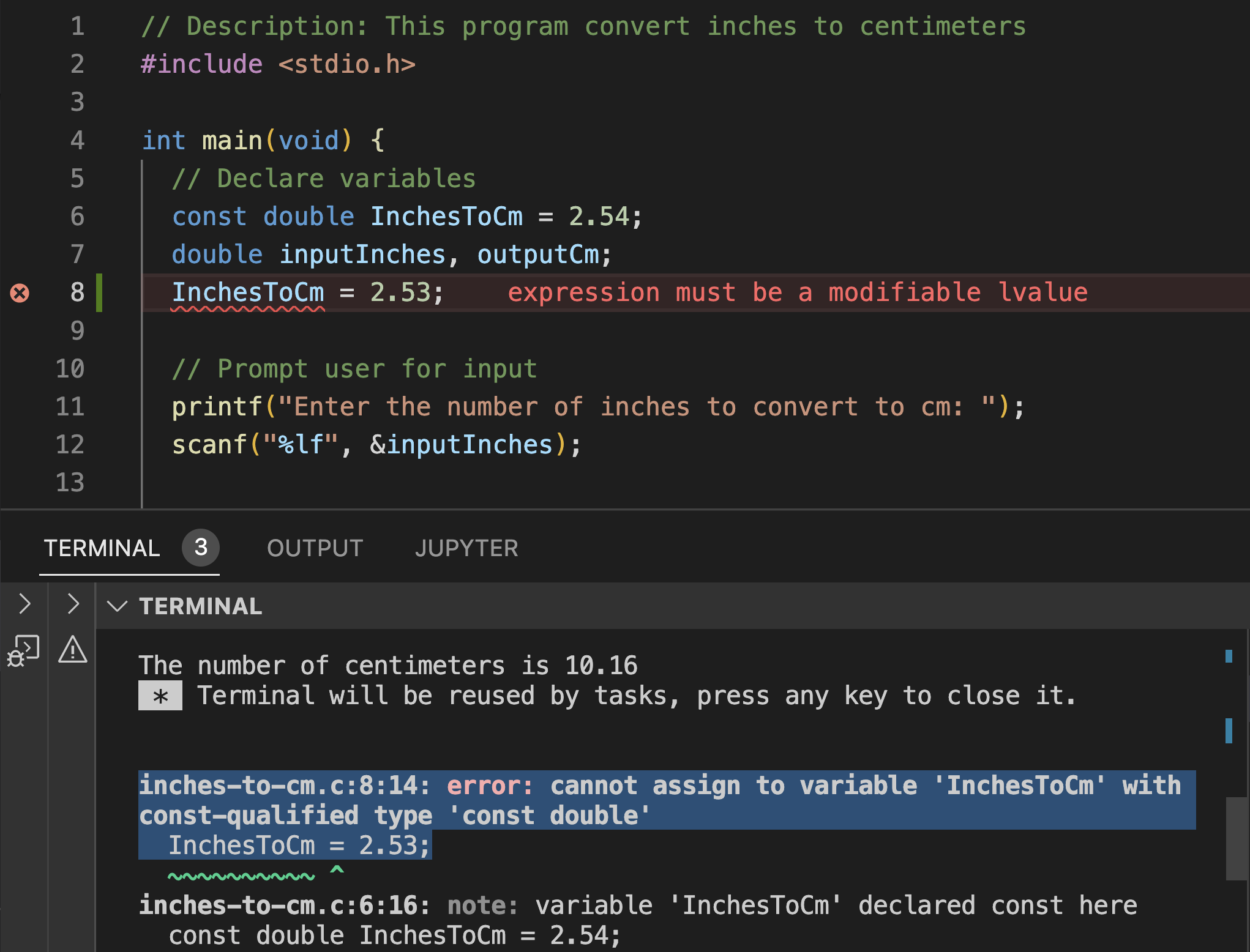Double data type for real numbers
Contents
2.1. Double data type for real numbers#
In the previous chapter, we developed a program to calculate the number of slices in a number of pizzas. The number of slices and pizzas were considered integers, i.e. whole numbers with no fractions. However, if a kid decided to take a bite and run 🏃♀️, we will be left with a fraction of a slice. At this point, we need fractional numbers/real numbers. Another example, if we want to convert temperatures from Celsius to Fahrenheit, or centimeters to inches, we need to use fractional numbers - with decimal component. In this section, we will see how to represent numbers using fractional in our programs.
2.1.1. Example: Convert Inches to Centimeters#
Write a program that converts inches to centimeters. The program should prompt the user for a number of inches and then output the equivalent number of centimeters. The conversion factor is \(2.54\) centimeters per inch. Download inches-to-centimeters.c to get the following source code.
// Description: This program convert inches to centimeters #include <stdio.h>
int main(void){ // Declare variables const double InchesToCm = 2.54; double inputInches, outputCm;
// Prompt user for input printf("Enter the number of inches to convert to cm: "); scanf("%lf", &inputInches); // Convert inches to centimeters outputCm = inputInches * InchesToCm;
// Display output in 2 decimal places printf("The number of centimeters is %.2lf\n", outputCm); return 0; }
Let’s understand what each line is doing.
const double InchesToCm = 2.54;.
constis a keyword that indicates that the variableInchesToCmis a constant. The variableInchesToCmcannot be changed throughout the code. This will cause an error during compilation.Exercise: Change a constant variable
When I added in line 8
InchesToCm = 2.53;, which changes aconstvariable, the compiler gave me the following error. This is helpful because theconstkeyword guards against mistakenly changing a variable.
Fig. 2.1 Changing a constant variable compilation error#
doubleis a data type that indicates that the variableInchesToCmis a fractional number.Think!
What would happen if a number with decimal is stored in an
int🤔?If a number with decimal is stored in an
int, the decimal part will be truncated. For example, if we store2.54in anint, the value actually stored will be2.2.54is the value assigned to the variableInchesToCm.
double inputInches, outputCm; declares two variables of type double. The variables inputInches and outputCm are used to store the input and output values of the program. These inputs can be fractional numbers.
printf("Enter the number of inches to convert to cm: "); prints on the monitor a prompt to ask the user to enter inches to convert.
scanf("%lf", &inputInches); reads the input from the user and stores it in the variable inputInches. The %lf is a format specifier that indicates that the input is a fractional number. The & is the address-of operator that indicates the address of the variable inputInches. The address of a variable is the location in memory where the variable is stored. The scanf function will store the input in the memory location of the variable inputInches.
outputCm = inputInches * InchesToCm; will multiply the value in inputInches and InchesToCm and store the result in outputCm. The * is the multiplication operator.
printf("The number of centimeters is %.2lf\n", outputCm); prints on the monitor the value of outputCm with 2 decimal places. The %lf is a format specifier that indicates that the value is a fractional number. The .2 indicates that the value should be printed with 2 decimal places.
2.1.2. Summary#
So far we discussed two data types in C:
int: It stores a whole number/integer, either 0, negative or positive. For example, 0, -1, or 100 are all integers. Format specifier ofintis%d.double: It stores a fractional number, which is any number on the number line. For example, -2.1, 0.0001, or 3.14 are all fractional numbers. Format specifier ofdoubleis%lf.
When you are planning your program, you must think of the variables you need and their data types. For example, if you have a variable storing:
number of attendees:
intprice of a ticket:
doublenumber of protons in Calcium:
const intvalue of \(\pi\):
const double
In the next section, we will see are these data types stored in the memory.
Quiz
0 Questions
